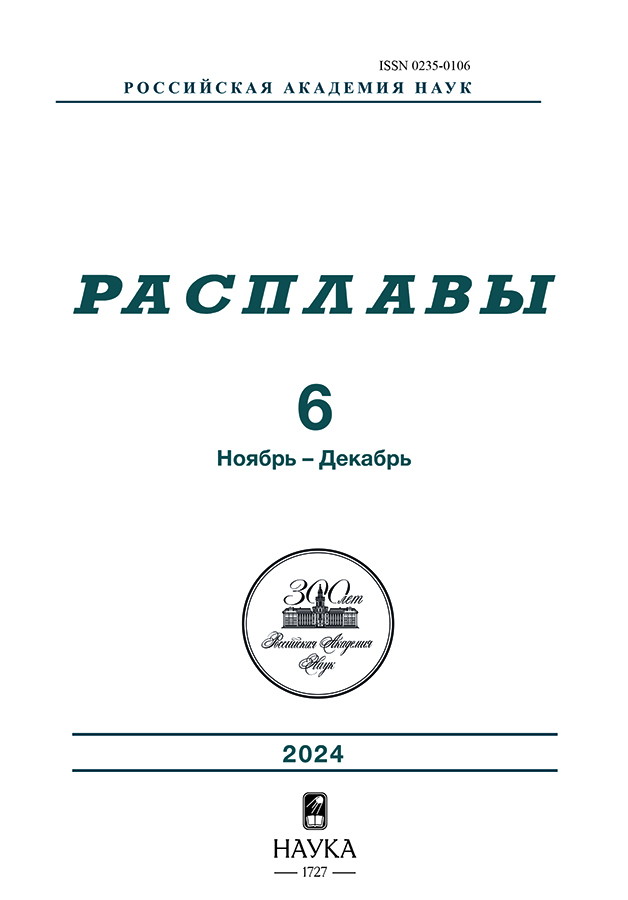Cluster structure of nickel and its alloys with chromium in the liquid state
- Authors: Tyagunov A.G.1, Baryshev E.E.1, Tyagunov G.V.1, Zaitseva N.A.1, Mushnikov V.S.1
-
Affiliations:
- Ural Federal University
- Issue: No 6 (2024)
- Pages: 624-632
- Section: Articles
- URL: https://ruspoj.com/0235-0106/article/view/661968
- DOI: https://doi.org/10.31857/S0235010624060043
- ID: 661968
Cite item
Abstract
Modern ideas about the structure of liquid metals and alloys are considered. The main emphasis is placed on the cluster model and its structural parameters. The effect of chromium concentration in nickel-chromium melts on the change in the parameters of the cluster structure is shown. The calculation results are compared with the previously obtained experimental X-ray diffraction data and the results of studying the temperature dependences of the physical properties of nickel and its alloys with chromium in the liquid state. Attention is drawn to the fact that at a temperature close to 1900ºС the cluster radius becomes less than 10 Ǻ and these are the critical temperatures characteristic of binary and multicomponent nickel melts, upon reaching which structural changes occur in the melts and the metallic liquid becomes more equilibrium. and microhomogeneous.
Full Text
About the authors
A. G. Tyagunov
Ural Federal University
Email: e.e.baryshev@urfu.ru
Russian Federation, Yekaterinburg
E. E. Baryshev
Ural Federal University
Author for correspondence.
Email: e.e.baryshev@urfu.ru
Russian Federation, Yekaterinburg
G. V. Tyagunov
Ural Federal University
Email: e.e.baryshev@urfu.ru
Russian Federation, Yekaterinburg
N. A. Zaitseva
Ural Federal University
Email: n.a.zaitceva@urfu.ru
Russian Federation, Yekaterinburg
V. S. Mushnikov
Ural Federal University
Email: e.e.baryshev@urfu.ru
Russian Federation, Yekaterinburg
References
- Yelanskii G.N., Yelanskii D.G. Stroyeniye i svoystva metallicheskikh rasplavov [Structure and properties of metallic melts]. M.: MGVMI, 2006. [In Russian].
- Mogutnov B.M., Tomilin I.A., Shvartsman L.A. Termodinamika splavov zheleza [Thermodynamics of iron alloys]. M.: Metallurgya, 1984. [In Russian].
- Baum B.A., Khasin G.A., Tyagunov G.V, et al. Zhidkaya stal’ [Liquid steel]. M.: Metallurgya, 1984. [In Russian].
- Sommer F. Association model for the description of the thermodynamic functions of liquid alloys. I. Basic concepts // Z. Metallkunde. 1982. 73. № 2. P. 72–86.
- Zaitsev A.I., Shelkova H.E., Mogutnov B.M. Assotsiatsiya v metallicheskikh rasplavakh [Association in metallic melts] // Abstracts of reports of the IX All-Russian conference “ Stroyeniye i svoystva metallicheskikh i shlakovykh rasplavov” [Structure and properties of metallic and slag melts]. Chelyabinsk: Publishing house of South Ural State University. 1998. 1. P. 39–41. [In Russian].
- J. O. Andersson, J. Ågren. Models for numerical treatment of multicomponent diffusion in simple phases // Journal of Applied Physics. 1992. 72. P. 1350–1355.
- J. O. Andersson, T. Helander, L. Höglund, P. F. Shi, B. Sundman. Thermo-Calc and DICTRA, Computational tools for materials science // Calphad. 2002. 26. P. 273–312.
- Popel P.S., Sidorov V.E., Brodova I.G., Kalvo-Dahlborg M., Dahlborg U. Vliyaniye termicheskoy obrabotki iskhodnogo rasplava na strukturu i svoystva kristallicheskikh slitkov ili otlivok [Effect of heat treatment of the initial melt on the structure and properties of crystalline ingots or castings] // Rasplavy. 2020. № 1. P. 3–36. [In Russian].
- Gavrilin I.V. Plavleniye i kristallizatsiya metallov i splavov [Melting and crystallization of metals and alloys]. Vladimir: State University, 2000. [In Russian].
- Zin Min U., Miloserdii V.Yu., Samosadny V.T., Kolotushkin V.P., Rechitsky V.N. Issledovaniye vliyaniya legirovaniya i termoobrabotki na elektronnuyu strukturu i defekty struktury splavov Ni- Cr metodom annigilyatsii pozitronov [Study of the effect of alloying and heat treatment on the electronic structure and structural defects of Ni-Cr alloys by the positron annihilation method] // Fizika i khimiya obrabotki materialo . 2005. № 4. P. 12–16. [In Russian].
- Grafutin V.I., Prokopiev E.P. Primeneniye pozitronnoy annigilyatsionnoy spektroskopii dlya izucheniya stroyeniya veshchestva [Application of positron annihilation spectroscopy to study the structure of matter] // Uspekhi fizicheskikh nauk. 2002. 172. № 1. P. 67–83. [In Russian].
- Baryshev E.E., Tyagunov A.G., Stepanova N.N. Vliyaniye struktury rasplava na svoystva zharoprochnykh nikelevykh splavov v tvordom sostoyanii [Effect of melt structure on the properties of heat-resistant nickel alloys in the solid state]. Yekaterinburg: IPM UBRAS. 2010. [In Russian].
- Grigorovich V.K. Metallicheskaya svyaz’ i struktura metallov [Metallic bond and structure of metals]. M.: Nauka, 1998. [In Russian].
Supplementary files














